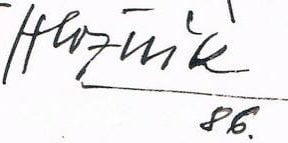Ferdinand Hložník is among the most significant figures in the Slovak modern art.
The exhibition commemorates the centenary of the birth of Ferdinand Hložník, a member of the memorable WWII Generation that entered the Slovak art scene in very tough times. These artists started to shape their work during the war and in the post-war period. Other members of the WWII Generation include Orest Dubay, Ladislav Guderna, Vincent Hložník, Viliam Chmel, Ján Novák, Ervín Semian, Jozef Šturdík, and Ernest Zmeták.
Ferdinand Hložník (1919 Svederník – 2006 Bratislava) is among the most significant figures in the Slovak modern art. He focused mainly on painting and drawing, but his illustrations and prints are of special importance, too.
The exhibition presents the artist´s works from the Nedbalka Gallery´s depository. It provides insight into the creative period of 1958 – 1980. The exhibition focuses on the works from the sixties, the most important period within the artist oeuvre. Chronologically, the exhibition starts with the works from the late 1950s. The period of 1950 – 1958 was dominated by images of the artist´s native village of Svederník, landscapes, and family scenes. Furthermore, the artist also dealt with the current social issues, such as the threats to human life, which took the form of fallen and living soldiers in his paintings.
In the next decade, the artist continued in developing his constant values and started incorporating the new ones. He made pictures at the boundary of figurative and abstract art, while never really abandoning the figuration. The symbol, the sign and associative elements entered his works with increasing urgency. In the context of the then development, the artist was a proponent of progressive trends in local art, along with the representatives of different, mostly younger, generations. He was developing the basic semantics of Expressionism and the expression as a concept and a programme of the significant part of our modern culture in a very inventive manner. Later he turned his attention also to the depiction of states of mind and moods, just like in the 1960s. In the 1970s, he extended the area of his subjects to include people talking together or resting. The emphasis was put on the symbol and archetype. A typical iconographic specific of Hložník´s paintings can be considered the variability and the continuation. Initially, the variability brings new iconographic themes or unexpected updates, however, once the iconography is relatively stabilised, it takes the form of modifications. The continuation of iconography can be described as a stable iconographic repertory to which the artist permanently returned.
The exhibition of selected works by Ferdinand Hložník at the Nedbalka Gallery cannot be considered a final appreciation of his oeuvre. Yet, it is an important step towards a proper understanding of his body of work from today´s perspective. It opens the door to a deeper understanding of both the artist´s importance and his message. Furthermore, the exhibition also brings a necessary stimulus for the re-evaluation of the artist´s incorporation into the history of Slovak modern fine art.
Ferdinand Hložník
Ferdinand Hložník, a younger brother of Vincent Hložník, was born on 18 November 1919. He studied at the Department of drawing and painting, the Slovak University of Technology in Bratislava (1942–1946, Profs. Ján Mudroch, Gustáv Mallý, Maximilián Schurmann, Dezider Milly). He worked as a teacher at the gymnasiums in Svätý Jur (1947–1948) and Bratislava (1948–1952). From 1952 to 2006 he was a free-lance artist. In 1967, he was awarded the prestigious Cyprián Majerník Award, in 1976 he received Fraňo Kráľ Award for illustrations. In 1982, he was awarded the title “Meritorious artist”. He died on 27 February 2006 and is buried in the Slávičie údolie cemetery in Bratislava.
Some things you can enjoy only live
Address
-
Galéria Nedbalka, n. o.
Nedbalova ulica 17
811 01 Bratislava
tel.: +421 2 20 76 60 31
Opening hours
- Open daily
- except Mondays
- 13.00 – 19.00
-
Open

